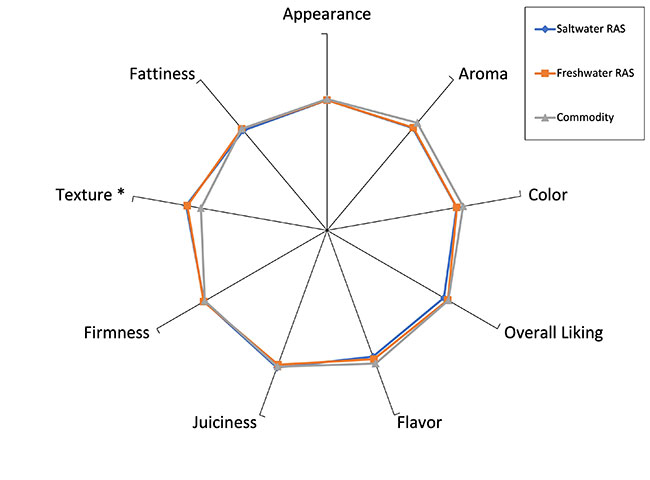
Features
Fresh Tips: The RAS salmon taste test
October 27, 2022 By From the experts at the Freshwater Institute
 Radar figure comparing liking scores of several attributes of saltwater RAS, freshwater RAS and commodity Atlantic salmon. Asterisks denote statistically significant difference in texture. (Image: Freshwater Institute)
Radar figure comparing liking scores of several attributes of saltwater RAS, freshwater RAS and commodity Atlantic salmon. Asterisks denote statistically significant difference in texture. (Image: Freshwater Institute) Many RAS-grown fish are marketed as local, sustainable options. While these characteristics are commonly pointed out as differentiators, how does the eating experience compare? Atlantic salmon from both a freshwater and saltwater RAS producer were compared to commodity salmon by a 100-person tasting panel of salmon users to find out.
The three varieties of salmon were obtained from a processor and shipped to a consumer sensory testing centre. Each fillet portion was drizzled with one tablespoon of olive oil and one teaspoon of course salt and baked at 400 F to an internal temperature of 145 F. All three salmon were served one by one to each member of the tasting panel in a randomized order and panelists were asked to score their liking of several attributes on a nine-point scale from “Extremely Dislike” to “Extremely Like”.
Visual appearance, aroma, and colour were judged before tasting. Scores in these attributes for the three salmon varieties ranged from 5.96 to 6.43, or the “Slightly Like” category. There were no statistical differences detected in liking between the three salmon types, however, JAR scoring indicated that colour in the two RAS produced fish could be improved to be darker or brighter.
Panelists were then asked to taste the fillets portions. Scores for the tasting attributes flavour, juiciness, firmness, and fattiness ranged from 5.97 to 6.69, which fits between the “Slightly” to “Moderately Like”. Once more, no differences in liking score were detected for these attributes.
In the flavour category, JAR scores determined that salmon from the saltwater RAS was “Slightly Too Strong” while flavour from salmon grown in the freshwater RAS was judged “Too Weak.” Commodity salmon flavour was judged to be “Just About Right.” In the case of firmness, salmon from the saltwater RAS was judged to be “Just About Right” while both freshwater RAS and commodity salmon were “Slightly Too Soft.”
Texture was the only attribute in which significant differences in liking score were detected, with both RAS-produced fish scoring higher than commodity salmon. Salmon from saltwater RAS (6.54) and freshwater RAS (6.49) scored between “Slightly” and “Moderately Like” while commodity salmon (5.86) scored just below “Slightly Like”. Higher texture scores from the RAS salmon suggest differences in the many factors known to impact this attribute.
Some explanations for this difference could include the effects of continuous swimming exercise on muscle tissues or shorter delivery times to processors and consumers made possible by local production. Despite this difference in texture liking, the final “Overall Liking” score was no different for any of the salmon.
After scoring for appearance and taste, panelists were asked to rate their purchase intent for each portion of salmon. All of the salmon were scored neutrally between 3.15 and 3.31 (“Might Or Might Not Buy”) with no differences in purchase intent between any of the salmon options. Panelists were then asked if each salmon fillet was produced locally, would they prefer to purchase that fillet over one produced in Norway, Chile, or Canada. Thirty-nine per cent of panelists said they would prefer the locally produced RAS fish to imported options, while 19 per cent said they would not. The final 42 per cent said where the fish was produced would make no difference.
Panelists were further asked if they would pay a premium price for each salmon had it been produced locally. Twenty-six per cent said they would, while 45 per cent said they would not, and 29 per cent said this would make no difference. While there appeared to be a preference for locally produced fish, a smaller portion of consumers would be willing to pay an unspecified premium. While locally produced RAS supply is low, targeting select consumers could provide a benefit through premium price. However, as supply increases, relying on locally produced preference to increase volume sold with prices closer to those of commodity salmon could be a longer-term competitive advantage for RAS grown fish.
Liking and purchase intent for Atlantic salmon grown in either freshwater or saltwater RAS were similar to each other and to commodity salmon. Fish grown in RAS had a preferred texture and this or the underlying reasons could be a differentiator for RAS grown fish.
Print this page